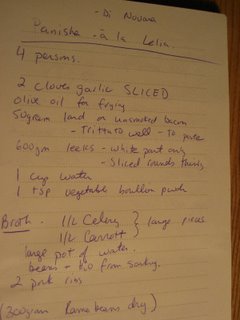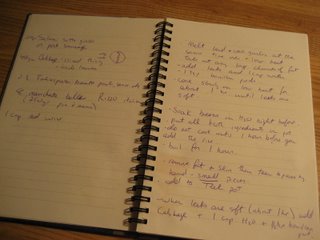There is a back story, though. Many years ago, my father (who was a serious foodie) always raved about how good my aunt Lelia's Paniscia was. I really had nothing to compare it too, since it was a traditional food and I have only ever eaten at my aunt's table. However, as I grew up and became more educated about food, I realized what an unusual dish it was. Especially to us North Americans who associate Italian food with pasta and pizza.
So, on my last trip over to visit in 2001, I asked my aunt if she would teach me how to make it.
What follows now is what I learned.
This recipe is one that my aunt actually had to cook, since it is very much one of thoses recipes where you "add what looks about right" for quantities. She wound up measuring out her handfuls and pinches etc on a scale so we would have an idea of the quantity.
Here are some pictures of my "working recipe" that I wrote down as my aunt and I cooked.



If you look closely (and can read my handwriting), you will find a mishmash of Italian and English written down. Every time I make this recipe, it makes me laugh.
Now, I am going to add, that this recipe is traditional to my families' hometown Novara, Italy. However, my aunt's version of it is not the "gourmet" version you see on the link earlier in the post. This is the peasant version that could be left over the fire to cook for hours while everyone was out working on the fields, milking cows etc. Not that this is not very tasty. Apparently whenever my aunt and family are going to a pot-luck, several requests are placed that she bring this dish!
You didn't think I would make you try to do this recipe from my awful scrawled notes, though, did you? Here is the cleaned up version:
Paniscia A La Lelia
Approx 4 people
Ingredients
2 cloves garlic, sliced (chopped tends to burn)
olive oil
50gm lard or unsmoked bacon (pork belly) chopped up until it resembles paste
600gm leeks, cut into thin rounds. Use only white part
1 cup water
bouillon cube/powder
200gm pork sausage (I use Italian mild from the butcher)(1/2 of an average sized sausage), removed from casing and torn into very small pieces
450gm cabbage sliced thinly, just use inside leaves
2-3 tblsp tomato paste
300gm dry Romano beans or 1 can Romano beans
250gm Italian long grain or arborio rice
1/2 to 1 cup red wine.
Broth-carrot, celery, pork rib if desired
Directions
Start broth day before. Put carrot & celery, pork rib (if using) and beans(if using dry) in large pot of water. Bring to a boil and boil for at least 1 hour or until beans are tender. Save broth (and beans)in fridge for next day.
Melt lard/pork belly in large pot over low heat. Cook garlic slices at the same time.After fat looks melted or translucent, pull out any large chunks of fat.(you don't want to bite into rubbery fat when you are eating, do you???)
Add leeks, 1 cup of water, bouillon cube/powder for 1 cup of water
Add torn up sausage. .
Slowly cook on low heat until leeks are soft. About 1 hour.
When leeks are soft, add cabbage, and a cup of broth .
Cover and stir occasionally for at least 3 hours on low heat. Cabbage should be completely mushy and soft. Add broth as needed to keep moist.
When cabbage is soft, add tomato paste, rice, salt (if desired), 1/2 cup of red wine (or however much you want). Stir. Add enough broth to keep very moist so rice will cook. Stir frequently and add broth as needed for about 20 minutes or until rice is cooked through.
Add cooked beans and fold them in gently.
Serve with grated parmesan. ( I prefer Reggiano)
The pork ribs are optional. I rarely use them and don't notice the difference! I also prefer canned beans since they tend to be softer than cooked beans from dry. But use whatever you want. That is the beauty of Italian cuisine. Change and add till you like it! As a final note, don't use "cooking" wine. The flavour will be concentrated down, and if you don't like it...well you get the idea. Only ever cook with wine you would drink!
Merry Christmas!

















